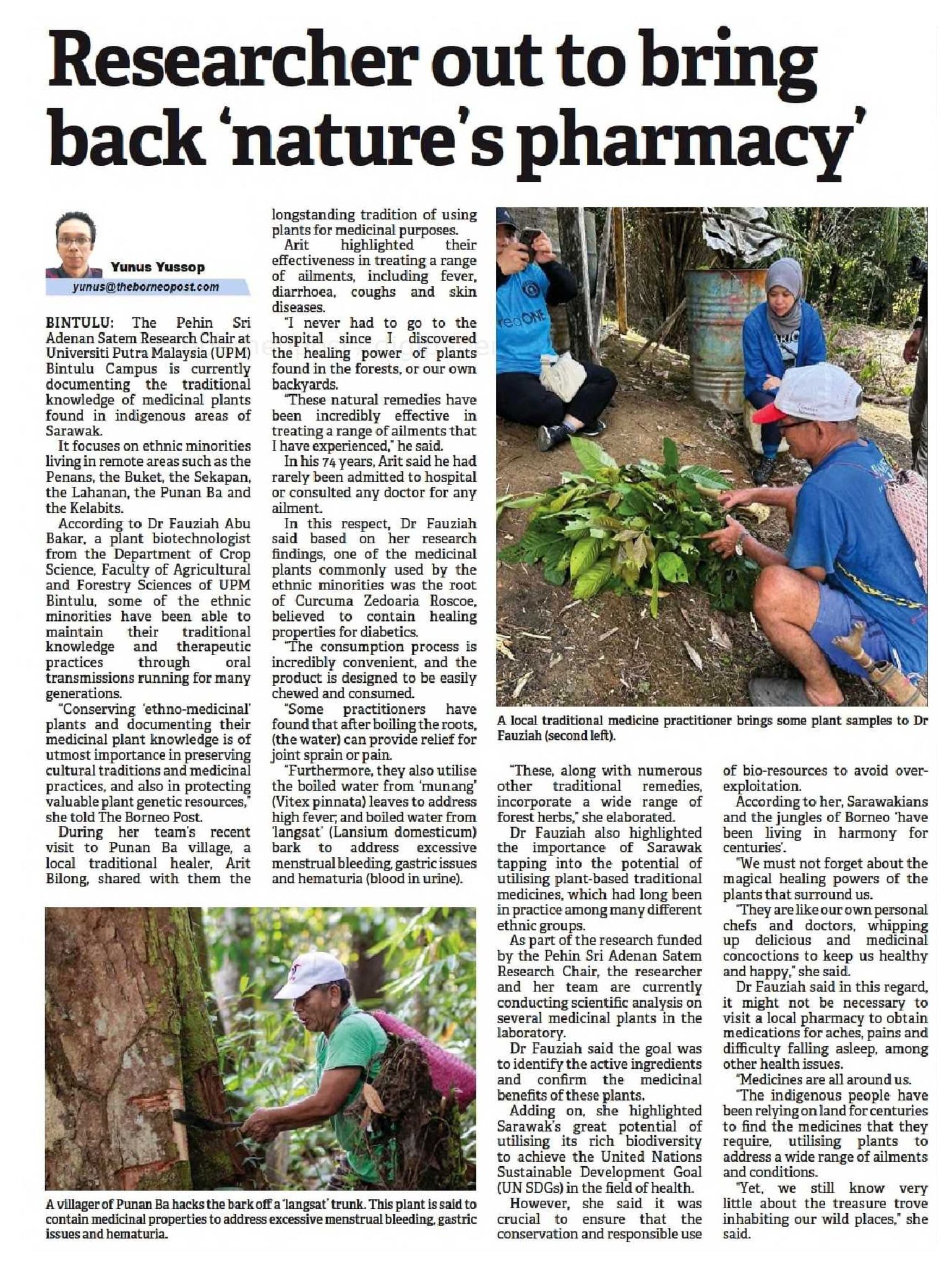BINTULU (March 10): The Pehin Sri Adenan Satem Research Chair at Universiti Putra Malaysia (UPM) Bintulu Campus is currently documenting the traditional knowledge of medicinal plants found in indigenous areas of Sarawak.
It focuses on ethnic minorities living in remote areas such as the Penans, the Buket, the Sekapan, the Lahanan, the Punan Ba and the Kelabits.
According to Dr Fauziah Abu Bakar, a plant biotechnologist from the Department of Crop Science, Faculty of Agricultural and Forestry Sciences of UPM Bintulu, some of the ethnic minorities have been able to maintain their traditional knowledge and therapeutic practices through oral transmissions running for many generations.
“Conserving ‘ethno-medicinal’ plants and documenting their medicinal plant knowledge is of utmost importance in preserving cultural traditions and medicinal practices, and also in protecting valuable plant genetic resources,” she told The Borneo Post.
During her team’s recent visit to Punan Ba village, a local traditional healer, Arit Bilong, shared with them the longstanding tradition of using plants for medicinal purposes.
Arit highlighted their effectiveness in treating a range of ailments, including fever, diarrhoea, coughs and skin diseases.
“I never had to go to the hospital since I discovered the healing power of plants found in the forests, or our own backyards.
“These natural remedies have been incredibly effective in treating a range of ailments that I have experienced,” he said.
In his 74 years, Arit said he had rarely been admitted to hospital or consulted any doctor for any ailment.
In this respect, Dr Fauziah said based on her research findings, one of the medicinal plants commonly used by the ethnic minorities was the root of Curcuma Zedoaria Roscoe, believed to contain healing properties for diabetics.
“The consumption process is incredibly convenient, and the product is designed to be easily chewed and consumed.
“Some practitioners have found that after boiling the roots, (the water) can provide relief for joint sprain or pain.
“Furthermore, they also utilise the boiled water from ‘munang’ (Vitex pinnata) leaves to address high fever; and boiled water from ‘langsat’ (Lansium domesticum) bark to address excessive menstrual bleeding, gastric issues and hematuria (blood in urine).
“These, along with numerous other traditional remedies, incorporate a wide range of forest herbs,” she elaborated.
Dr Fauziah also highlighted the importance of Sarawak tapping into the potential of utilising plant-based traditional medicines, which had long been in practice among many different ethnic groups.
As part of the research funded by the Pehin Sri Adenan Satem Research Chair, the researcher and her team are currently conducting scientific analysis on several medicinal plants in the laboratory.
Dr Fauziah said the goal was to identify the active ingredients and confirm the medicinal benefits of these plants.
Adding on, she highlighted Sarawak’s great potential of utilising its rich biodiversity to achieve the United Nations Sustainable Development Goal (UN SDGs) in the field of health.
However, she said it was crucial to ensure that the conservation and responsible use of bio-resources to avoid over-exploitation.
According to her, Sarawakians and the jungles of Borneo ‘have been living in harmony for centuries’.
“We must not forget about the magical healing powers of the plants that surround us.
“They are like our own personal chefs and doctors, whipping up delicious and medicinal concoctions to keep us healthy and happy,” she said.
Dr Fauziah said in this regard, it might not be necessary to visit a local pharmacy to obtain medications for aches, pains and difficulty falling asleep, among other health issues.
“Medicines are all around us. The indigenous people have been relying on land for centuries to find the medicines that they require, utilising plants to address a wide range of ailments and conditions.
“Yet, we still know very little about the treasure trove inhabiting our wild places,” she said.

Tarikh Input: 13/03/2024 | Kemaskini: 13/03/2024 | lanz
PERKONGSIAN MEDIA
































